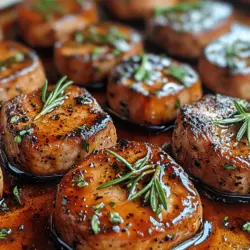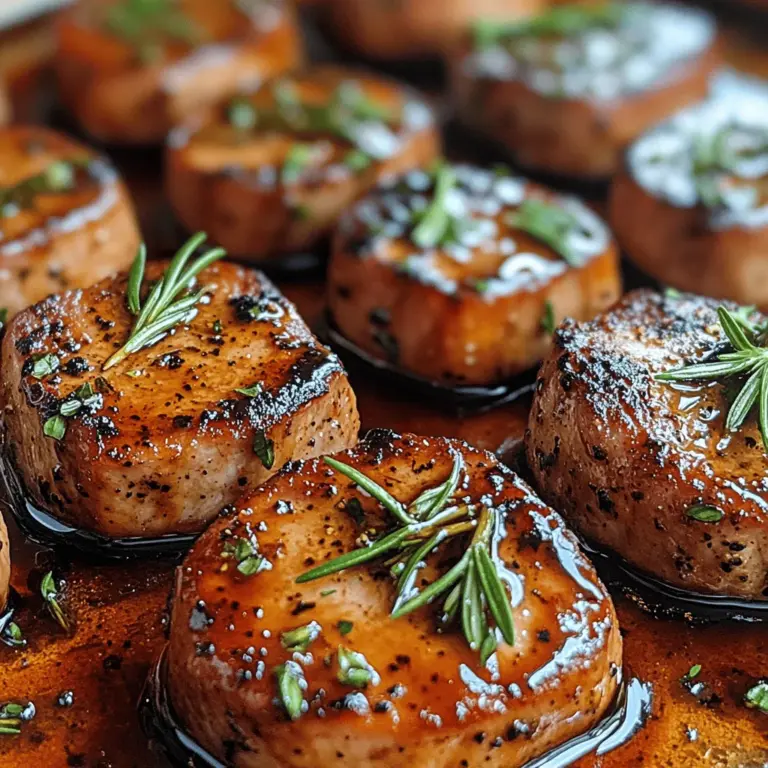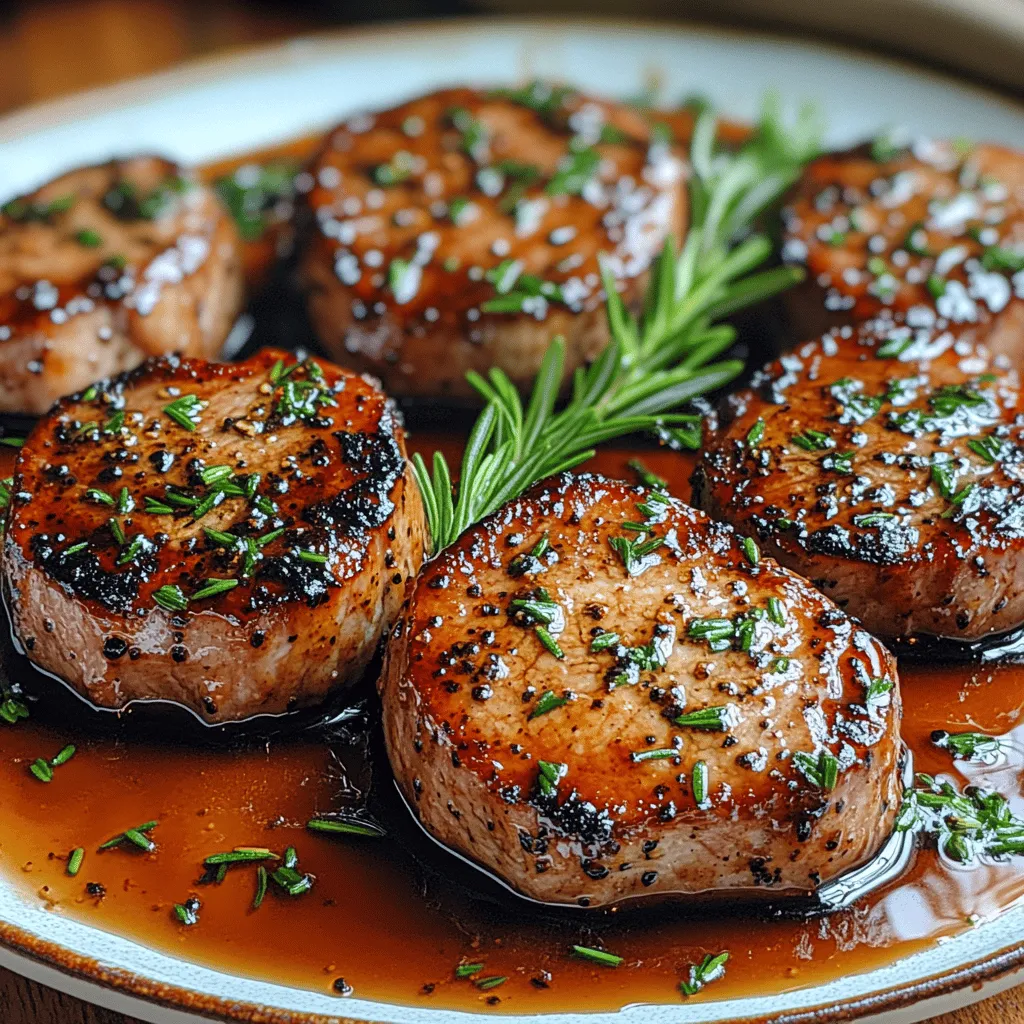Introduction
Balsamic Bliss Pork Tenderloin is a dish that encapsulates the essence of home-cooked comfort while delivering a burst of sophisticated flavors that can impress even the most discerning guests. The rich, tangy notes of balsamic vinegar combined with the natural sweetness of honey create a perfect harmony that elevates the tender pork to new heights. This recipe is not just about cooking; it’s about creating an experience that can transform an ordinary weeknight dinner into a memorable occasion or serve as a centerpiece for special celebrations.
One of the most appealing aspects of this dish is its versatility. Whether you’re hosting a dinner party, celebrating a holiday, or simply enjoying a quiet meal with your family, Balsamic Bliss Pork Tenderloin fits the bill beautifully. Its simple preparation, coupled with robust flavors, makes it a go-to choice for cooks of all skill levels. In this article, we will delve into the rich background of this dish, explore the characteristics of pork tenderloin, break down each ingredient, and guide you through the marinating process that enhances the flavor and tenderness of the meat.
Understanding Pork Tenderloin
Pork tenderloin is a prized cut of meat known for its tenderness and mild flavor. This long, narrow cut comes from the muscle that runs along the spine, making it one of the most tender parts of the pig. Because of its lean nature, pork tenderloin is a healthy option that cooks quickly, making it ideal for busy weeknights or last-minute meals.
One of the significant benefits of cooking with pork tenderloin is its versatility. It can be prepared in various ways—grilled, roasted, or sautéed—and pairs well with an array of flavors, from sweet to savory. This adaptability allows home cooks to experiment with different marinades and seasonings, making it a favorite in many kitchens.
However, to truly unlock the potential of pork tenderloin, marinating is essential. Marinating not only infuses the meat with flavor but also helps to tenderize it further, ensuring a juicy and flavorful bite. The right marinade can enhance the natural flavors of the pork while adding complexity and depth to the overall dish.
Ingredients Breakdown
To create the Balsamic Bliss Pork Tenderloin, a selection of carefully chosen ingredients is critical. Each component plays a role in building the dish’s flavor profile, ensuring that every bite is a delightful experience. Let’s break down each ingredient in detail.
Pork Tenderloin
When sourcing pork tenderloin, look for quality meat that is pinkish-red in color, with minimal marbling and a firm texture. Organic or pasture-raised pork is often preferred for its superior flavor and ethical sourcing. The tenderness of the pork makes it a prime candidate for marinades, allowing the flavors to penetrate deeply.
Balsamic Vinegar
Balsamic vinegar is the star of this dish, providing a tangy and slightly sweet flavor that complements the pork beautifully. There are different types of balsamic vinegar, ranging from traditional balsamic from Modena, Italy, to more commercially produced varieties. For this recipe, opt for a high-quality balsamic vinegar that boasts a rich flavor profile—this will significantly enhance the dish. Look for labels that indicate “aged” or “traditional” for the best results.
Honey
Honey plays a crucial role in balancing the acidity of the balsamic vinegar. It adds a natural sweetness that contrasts beautifully with the tanginess of the vinegar, making the dish more palatable and enjoyable. When selecting honey, consider using raw or local varieties, as they often have unique flavors and health benefits that can enhance your dish.
Garlic
Garlic is a must-have ingredient in this recipe, contributing both flavor and health benefits. Rich in antioxidants and known for its anti-inflammatory properties, garlic enhances the overall taste of the dish. Fresh garlic cloves, minced or crushed, will impart a stronger flavor compared to pre-packaged garlic products.
Dijon Mustard
Dijon mustard adds a layer of complexity to the marinade, providing a subtle heat and depth that elevates the dish. The mustard also acts as an emulsifier, helping to bind the ingredients together. When choosing Dijon mustard, look for varieties that are smooth and free from artificial additives for the best flavor.
Olive Oil
Olive oil is essential for cooking the tenderloin, as it provides moisture and helps to create a beautiful sear on the meat. It also works in the marinade to help coat the pork evenly. Extra virgin olive oil is the preferred choice due to its higher quality and flavor, which complements the other ingredients.
Fresh Herbs (Rosemary and Thyme)
Fresh herbs like rosemary and thyme add a fragrant, aromatic quality to the dish. They enhance the flavor of the pork and work harmoniously with the other ingredients. While dried herbs can be used in a pinch, fresh herbs provide a more vibrant taste and aroma, making them the ideal choice for this recipe.
Optional Ingredients
For those looking to take their Balsamic Bliss Pork Tenderloin to the next level, consider adding a touch of butter for glazing. This can enhance the richness of the dish and create a beautiful finish. Additionally, garnishing the dish with fresh herbs or a drizzle of balsamic reduction can elevate its presentation and flavor.
Marinade Magic
The marinade is where the magic happens for the Balsamic Bliss Pork Tenderloin. A well-executed marinade can transform an ordinary piece of meat into a flavor-packed masterpiece. Understanding the importance of marinating and how to do it properly is essential for achieving the best results.
Importance of Marinating
Marinating serves two primary purposes: enhancing flavor and tenderizing the meat. The combination of balsamic vinegar, honey, garlic, and mustard creates a flavorful mixture that penetrates the pork, infusing it with delicious notes. Additionally, the acidity in the balsamic vinegar helps break down the proteins in the meat, resulting in a tender and juicy final product.
Step-by-Step Guide to Preparing the Marinade
Creating the marinade is simple and requires just a few steps:
1. Gather Ingredients: Start by measuring out your balsamic vinegar, honey, minced garlic, Dijon mustard, and olive oil.
2. Whisk Together: In a medium bowl, combine the balsamic vinegar and honey. Whisk them together until the honey is fully dissolved into the vinegar.
3. Add Remaining Ingredients: Next, add the minced garlic, Dijon mustard, and olive oil. Continue whisking until all ingredients are well incorporated and the mixture is smooth.
Tips for Proper Marinating Techniques
To ensure maximum flavor absorption, follow these tips for marinating your pork tenderloin:
– Time: Marinate the pork for at least 30 minutes, but for optimal flavor, aim for 2-4 hours. If you have more time, marinating overnight in the refrigerator can yield even better results.
– Temperature: Always marinate the pork in the refrigerator to prevent any bacterial growth. Room temperature marinating can lead to food safety issues.
– Container Options: Use a resealable plastic bag or a shallow dish to marinate the pork. A bag allows for even coating of the marinade, while a dish can be easier for larger cuts.
Ideas for Variations in the Marinade
While the classic combination of balsamic vinegar, honey, and garlic is undoubtedly delicious, feel free to experiment with flavors. Consider adding spices like paprika or black pepper for extra heat, or incorporate citrus juice (like orange or lemon) to introduce a zesty note. You can also swap out the honey for maple syrup for a different kind of sweetness. The possibilities are endless, allowing you to customize the marinade to suit your taste preferences.
In the upcoming sections, we will explore the cooking process, provide tips for achieving the perfect tenderloin, and discuss serving suggestions that will make this dish a standout at any meal. Stay tuned for an exploration of how to transform your marinated pork tenderloin into a culinary masterpiece that delights the senses.
Cooking Process Overview
To create the perfect Balsamic Bliss Pork Tenderloin, understanding each step of the cooking process is essential. Let’s delve into the details:
Preheating the Oven: Why Temperature Matters
Preheating your oven is a fundamental step that should never be overlooked. It ensures that the pork tenderloin begins cooking at the right temperature, which is crucial for achieving a perfectly cooked dish. For this recipe, set your oven to 400°F (200°C). Preheating allows for an even cooking environment, helping to seal in the juices and flavors of the tenderloin right from the start.
Searing the Pork: Techniques for Achieving the Perfect Crust
Searing the pork tenderloin is a critical step that enhances flavor and texture. Start by seasoning your pork generously with salt and pepper. Heat a tablespoon of olive oil in a large, oven-safe skillet over medium-high heat. When the oil is shimmering but not smoking, add the pork tenderloin to the pan.
To achieve a golden crust, avoid moving the pork once it’s in the pan; let it sear undisturbed for about 3-4 minutes on each side. This caramelization process not only adds depth to the flavor but also creates a beautiful, appetizing crust. Once all sides are seared, remove the pork from the heat.
Pouring on the Marinade: Balancing Flavors and Moisture
After searing, it’s time to pour on the marinade. This recipe uses a combination of balsamic vinegar, honey, garlic, and herbs, which meld beautifully to create a sweet, tangy glaze that complements the pork. Pour the marinade over the seared tenderloin, ensuring it coats the meat evenly. This step not only infuses flavor but also helps to keep the pork moist during the baking process.
Importance of Temperature Control and Using a Meat Thermometer
Temperature control is vital when cooking pork tenderloin. The USDA recommends cooking pork to an internal temperature of 145°F (63°C) for safe consumption. Using an instant-read meat thermometer is the best way to ensure that your pork is perfectly cooked. Insert the thermometer into the thickest part of the tenderloin without touching any bones or the pan. Once it reaches 145°F, you can confidently remove it from the oven.
Perfecting the Bake
With the marinade in place, let’s focus on baking the pork tenderloin to perfection.
Explanation of Roasting: How It Differs from Other Cooking Methods
Roasting is a dry heat cooking method that surrounds the food with hot air, allowing it to cook evenly. This method differs from braising or stewing, where liquid is involved. Roasting helps develop flavors through caramelization, making it ideal for our balsamic pork tenderloin.
Ideal Cooking Time and Temperature for Pork Tenderloin
The ideal cooking time for pork tenderloin at 400°F (200°C) is approximately 20-25 minutes, depending on the size of the tenderloin. A 1-pound tenderloin will typically take about 20 minutes. Keep a close eye on the pork and check its internal temperature a few minutes before the expected cooking time to prevent overcooking.
Signs of Doneness: Understanding Internal Temperatures for Safety and Quality
In addition to using a meat thermometer, there are other signs you can look for to determine doneness. The pork should be slightly firm to the touch, with clear juices running from the meat. Additionally, the exterior should have a rich, caramelized color. However, the most reliable method remains checking the internal temperature.
Resting the Meat: Why It’s Crucial for Juiciness
Once the pork tenderloin reaches the desired temperature, remove it from the oven and let it rest for 5-10 minutes before slicing. Resting is crucial as it allows the juices to redistribute throughout the meat, ensuring each bite is tender and juicy. Cutting immediately can lead to a dry texture, as the juices will escape.
Creating the Glaze
The final touch to our Balsamic Bliss Pork Tenderloin is the glaze, which enhances both flavor and presentation.
The Role of Butter in the Sauce: Adding Richness and Depth
After removing the pork from the oven, you can create a sumptuous glaze using the remaining marinade. In the same skillet used for searing, add a couple of tablespoons of butter and heat over medium heat. Incorporate the leftover marinade, scraping up any flavorful bits from the bottom of the pan. The butter adds richness, while the glaze beautifully coats the pork, elevating its flavor profile.
Techniques for Incorporating the Glaze into the Dish
To incorporate the glaze effectively, first allow it to simmer for a few minutes, letting it reduce and thicken. Once it reaches a desirable consistency, return the sliced pork to the skillet, turning each piece to coat it in the glaze. This ensures that every bite is bursting with flavor.
Presentation Tips: How to Serve Elegantly for Dinner Parties
For an elegant presentation, slice the pork tenderloin into medallions and arrange them on a serving platter. Drizzle the balsamic glaze over the top and consider garnishing with fresh herbs, such as thyme or rosemary, for a pop of color. This not only enhances the visual appeal but also hints at the dish’s flavor profile.
Serving Suggestions
The right side dishes and accompaniments can elevate your Balsamic Bliss Pork Tenderloin to a whole new level.
Ideas for Side Dishes that Complement Balsamic Pork Tenderloin
– Roasted Vegetables: Seasonal roasted vegetables such as Brussels sprouts, carrots, and asparagus pair beautifully with the rich flavors of the pork.
– Garlic Mashed Potatoes: Creamy garlic mashed potatoes provide a comforting balance to the tangy glaze.
– Quinoa Salad: A light quinoa salad with fresh herbs, cherry tomatoes, and a lemon vinaigrette offers a refreshing contrast.
– Sautéed Greens: Lightly sautéed spinach or kale with garlic adds a nutritious green element to your plate.
Suggestions for Wine Pairings: Highlighting the Flavors of the Dish
When it comes to wine pairings, consider a medium-bodied red wine, such as Pinot Noir or Merlot. These wines have enough acidity to complement the balsamic vinegar while enhancing the dish’s flavors. Alternatively, a dry white wine like Sauvignon Blanc can also work well, particularly with the herbaceous notes of the dish.
Tips for Plating and Garnishing to Enhance Visual Appeal
Plating is an art that can make your dish stand out. Use a large, white plate to emphasize the colors of your dish. Arrange the pork medallions artfully, and don’t hesitate to layer your sides creatively. A sprinkle of fresh herbs or microgreens can add vibrant color and a touch of elegance. Serve with a small bowl of the balsamic glaze on the side for guests to drizzle as they please.
Nutritional Information
Understanding the nutritional profile of your meal can help you make informed choices.
Overview of the Nutritional Benefits of the Recipe
Pork tenderloin is an excellent source of high-quality protein, making it a great choice for a healthy meal. It is also rich in essential vitamins and minerals, such as B vitamins, zinc, and iron.
Breakdown of Calories, Protein, Fats, and Carbohydrates per Serving
For a typical serving of Balsamic Bliss Pork Tenderloin (approximately 4 oz of meat with glaze):
– Calories: 250
– Protein: 30g
– Fats: 10g (mostly from the glaze and marinade)
– Carbohydrates: 8g (mainly from honey and balsamic vinegar)
This combination makes it a balanced option for those looking to maintain a healthy diet while enjoying a flavorful meal.
Discussion on Dietary Considerations (e.g., Gluten-Free Options)
This dish is naturally gluten-free, as it does not contain any wheat-based ingredients. If you’re accommodating dietary restrictions, ensure that any additional sides or sauces are also gluten-free. Additionally, this recipe can be adapted to be lower in sugar by substituting honey with a sugar alternative if desired.
Conclusion
The Balsamic Bliss Pork Tenderloin is not just a meal; it’s an experience of flavor, technique, and presentation. The sweet and tangy glaze, combined with the tender and juicy pork, creates a dish that is sure to impress at any dinner table. With the right techniques and a little patience, you can master this recipe and bring joy to your dining experiences.
I encourage you to try this recipe and share it with your loved ones. Cooking is a joyful journey, and nothing is quite as satisfying as serving a homemade meal that warms the heart. Dive into the delightful world of flavors with this Balsamic Bliss Pork Tenderloin and discover the joy of cooking for family and friends.


